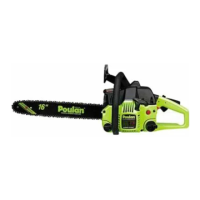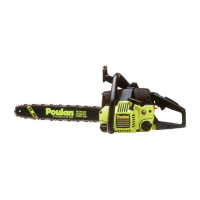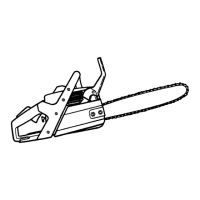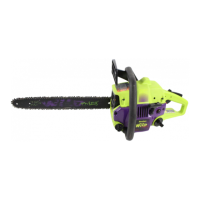Do you have a question about the Poulan Pro 2055 and is the answer not in the manual?
Explains general safety warnings and identifies key operational symbols for safe use.
Covers planning ahead, understanding the manual, and preparing for safe chain saw operation.
Details essential practices for safe chain saw operation, including grip, posture, and work area.
Outlines routine maintenance tasks and checks to keep the saw in optimal working condition.
Provides crucial safety instructions for handling, mixing, and storing gasoline and oil.
Explains rotational, pinch, and pull-in kickback phenomena and their underlying causes.
Offers strategies and techniques to minimize the risk of kickback during operation.
Details how to maintain proper grip, balance, and body positioning for effective saw control.
Describes built-in safety features designed to mitigate kickback hazards.
Explains features of low-kickback chains and guide bars designed to reduce kickback severity.
Details the function of the chain brake and the meaning of Computed Kickback Angle (CKA).
Advises on necessary precautions and protective gear before starting the assembly process.
Provides step-by-step instructions for correctly installing the guide bar and saw chain.
Guides on how to check and adjust the chain tension for optimal performance and safety.
Familiarizes the user with the various parts and controls of the chain saw.
Explains the purpose and operation of key controls like the ON/STOP switch and throttle trigger.
Describes the function of safety features such as the chain brake and chain tension.
Details the correct gasoline and oil mixture ratio and fueling process.
Explains the importance and process of lubricating the bar and chain.
Advises on best practices for storing fuel, especially concerning alcohol-blended fuels.
Covers essential safety warnings and initial procedures before starting the engine.
Provides a step-by-step guide for starting a cold or freshly refueled engine.
Outlines the correct steps for starting a warm engine.
Offers solutions for engines that are difficult to start or may be flooded.
Explains how the chain brake works and how to test its functionality.
Provides fundamental advice for effective and safe cutting techniques.
Details the notch method and procedures for felling trees larger than 6 inches in diameter.
Covers crucial planning steps, work area preparation, and safety considerations before felling trees.
Explains the process of bucking, or cutting felled trees into manageable log sizes.
Details methods for cutting logs that are not supported, focusing on safety and preventing pinching.
Describes cutting logs supported by a stand or another log, emphasizing compression side cuts.
Provides safety guidelines and techniques for pruning tree limbs up to shoulder height.
Covers safety awareness, footing, and techniques for removing limbs from a felled tree.
Covers general service precautions, maintenance schedule, and air filter care.
Details maintenance for muffler, screen, and carburetor adjustment procedures.
Covers cleaning oil holes, bar grooves, and addressing rail wear on the guide bar.
Provides information on chain sharpening and the steps for replacing the spark plug.
Outlines safety measures and fuel system preparation for storing the chain saw.
Provides contact information for customer assistance and service needs.
Lists common problems related to engine starting, running, and acceleration with remedies.
Addresses issues with engine idling, excessive smoking, and chain movement at idle.
Explains the duration, limitations, and conditions of the product's limited warranty.
Details the owner's role in maintenance and the manufacturer's obligations for emission control systems.
Specifies covered parts and guides on obtaining warranty service and filing claims.
Indicates the engine's certification standards for emissions based on usage type.
Explains general safety warnings and identifies key operational symbols for safe use.
Covers planning ahead, understanding the manual, and preparing for safe chain saw operation.
Details essential practices for safe chain saw operation, including grip, posture, and work area.
Outlines routine maintenance tasks and checks to keep the saw in optimal working condition.
Provides crucial safety instructions for handling, mixing, and storing gasoline and oil.
Explains rotational, pinch, and pull-in kickback phenomena and their underlying causes.
Offers strategies and techniques to minimize the risk of kickback during operation.
Details how to maintain proper grip, balance, and body positioning for effective saw control.
Describes built-in safety features designed to mitigate kickback hazards.
Explains features of low-kickback chains and guide bars designed to reduce kickback severity.
Details the function of the chain brake and the meaning of Computed Kickback Angle (CKA).
Advises on necessary precautions and protective gear before starting the assembly process.
Provides step-by-step instructions for correctly installing the guide bar and saw chain.
Guides on how to check and adjust the chain tension for optimal performance and safety.
Familiarizes the user with the various parts and controls of the chain saw.
Explains the purpose and operation of key controls like the ON/STOP switch and throttle trigger.
Describes the function of safety features such as the chain brake and chain tension.
Details the correct gasoline and oil mixture ratio and fueling process.
Explains the importance and process of lubricating the bar and chain.
Advises on best practices for storing fuel, especially concerning alcohol-blended fuels.
Covers essential safety warnings and initial procedures before starting the engine.
Provides a step-by-step guide for starting a cold or freshly refueled engine.
Outlines the correct steps for starting a warm engine.
Offers solutions for engines that are difficult to start or may be flooded.
Explains how the chain brake works and how to test its functionality.
Provides fundamental advice for effective and safe cutting techniques.
Details the notch method and procedures for felling trees larger than 6 inches in diameter.
Covers crucial planning steps, work area preparation, and safety considerations before felling trees.
Explains the process of bucking, or cutting felled trees into manageable log sizes.
Details methods for cutting logs that are not supported, focusing on safety and preventing pinching.
Describes cutting logs supported by a stand or another log, emphasizing compression side cuts.
Provides safety guidelines and techniques for pruning tree limbs up to shoulder height.
Covers safety awareness, footing, and techniques for removing limbs from a felled tree.
Covers general service precautions, maintenance schedule, and air filter care.
Details maintenance for muffler, screen, and carburetor adjustment procedures.
Covers cleaning oil holes, bar grooves, and addressing rail wear on the guide bar.
Provides information on chain sharpening and the steps for replacing the spark plug.
Outlines safety measures and fuel system preparation for storing the chain saw.
Provides contact information for customer assistance and service needs.
Lists common problems related to engine starting, running, and acceleration with remedies.
Addresses issues with engine idling, excessive smoking, and chain movement at idle.
Explains the duration, limitations, and conditions of the product's limited warranty.
Details the owner's role in maintenance and the manufacturer's obligations for emission control systems.
Specifies covered parts and guides on obtaining warranty service and filing claims.
Indicates the engine's certification standards for emissions based on usage type.
| Type | Gas Chainsaw |
|---|---|
| Engine Type | 2-Stroke |
| Displacement | 55 cc |
| Fuel Capacity | 16.9 fl oz |
| Bar Length | 20 in |












